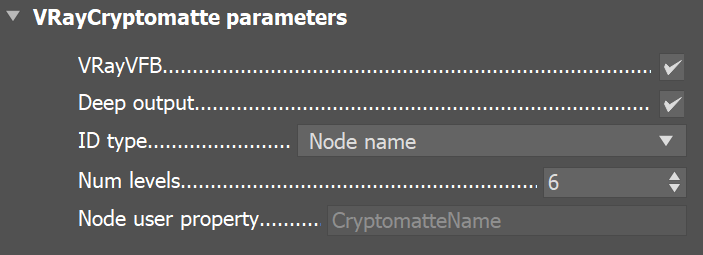This page gives information on the Cryptomatte Render Element.
Overview
Cryptomatte is a method developed by Psyop for efficiently encoding accurate mattes. It typically uses three to five automatically generated render channels stored in a multichannel OpenEXR file which removes the hassle of creating dozens or hundreds of Multimattes. Using the Cryptomatte plugin for NUKE or Fusion, mattes can be extracted through directly picking objects or entering object names.
Compared to the Multimatte Render Element, Cryptomatte offers the following:
- Does not require a setup with object IDs, etc.
- Only requires a fixed number of additional render elements, typically four.
- Cannot be propagated through reflections or refractions.
With V-Ray 5, update 2, the Cryptomatte Render Element works with Progressive Image Sampler as well.
The Cryptomatte Render Element supports reading of Multi/Sub-Object materials.
Parameters
This render element is enabled through the Render Elements tab of the Render Setup window in 3ds Max and displays its parameters in a rollout at the bottom of the window:
VRayVFB – When enabled, the render element appears in the V-Ray Frame Buffer.
Deep output – Specifies whether to include this render element in deep images.
ID type – Specifies how the ID mattes are determined.
Node name – Creates mattes by node names.
Node name with hierarchy – Creates mattes by node names and takes the node hierarchy into account for linked or grouped objects.
Node material name – Creates mattes based on the materials in the scene.
Node user property – Creates mattes from a property specified in the Node user property field.
Layer name – Creates mattes based on the layer names in the scene.
Num levels – Specifies the number of levels for the render element, which determines the number of objects that can be distinguished per pixel. If multiple objects intersect at a single pixel, higher-order elements contain non-zero results. The default value of 6 is normally enough for most cases.
Node user property – Specifies a user-defined property for creating ID mattes when ID type is set to Node user property.
Common Use
After producing a multichannel exr image with the Cryptomatte layer, we can use it in a compositing application, such as Nuke, to color correct the image. This example shows the before and after color correcting.
Notes
- When the V-Ray raw image file option is enabled from Render Settings > V-Ray > Frame buffer and the output is OpenEXR, you can choose to save the Cryptomatte channels as a separate EXR file. The option is available for both V-Ray CPU and V-Ray GPU rendering. Read more at Frame Buffer Settings.





